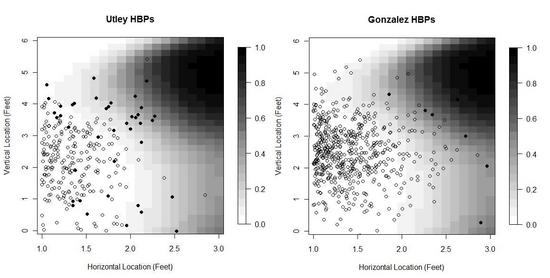
| Touching Bases | December 10, 2009 |
Roger Dorn earned back some respect when he showed that he was willing to take one for the team. But really, that pitch was so far up and in, it would’ve been more impressive to have seen him in his old age avoid it.
Some players, though, do have the ability to dodge pitches. Orlando Cabrera has seen over 5,000 pitches in the last two years, and has been able to get out of the way of all but one of them. At the other end of the spectrum, Chase Utley has taken his base on 51 HBPs in the last couple years, 21 more than the next closest batter.
Batters are hit in just over 1% of plate appearances when facing same-handed pitchers, while opposite-handed matchups result in half as many HBPs. 10% of pitches are inside in same-handed plate appearances, while 7% are inside in opposite-handed plate appearances. This explains some of the difference in hit by pitch probability. Using 2008-2009 pitchf/x data, I found the expected probability of a batter getting hit by a pitch that is at least a foot from the center of the plate—more or less all pitches that would normally be called for a ball inside.
The figure of the batter (borrowed from Mike Fast) stands approximately a foot off the plate.
Here you see that if you’re a pitcher and have the intent of throwing a bean ball, you should throw at the batter’s back, where 80-90% of pitches will hit him.
The portion from the knees down—about one and a half feet off the ground and lower—protrudes more gray area from the opposite-handed graphs from than from the same-handed graphs. The head area is also more of a danger zone for same-handed batters. My guess is that batters of the same handedness as the pitcher pick up the ball later in the pitcher's delivery than they do facing opposite-handed pitchers, and therefore same-handed batters have less time to react to the pitch as they realize it’s going to hit them.
I also considered that velocity might be a factor in hit by pitch expectancy. Again, my sample is restricted to pitches inside.
I’d imagine this trend has to do with the relationship between a pitcher’s velocity and his control. Breaking balls and 100 MPH heaters are not located as well as 90 MPH fastballs. But maybe batters are also more willing to get hit by the slowest pitches and not as able to get out of the way of the fastest pitches. I decided to include horizontal location, vertical location, and velocity as components in a regression to find the probability of HBPs.
| Player | Inside Pitches | Extra HBPs | HBP Probability |
|---|---|---|---|
| Chase Utley | 266 | 40 | 449% |
| Carlos Quentin | 288 | 26 | 442% |
| Jason Giambi | 255 | 22 | 502% |
| Kelly Shoppach | 231 | 21 | 414% |
| Aaron Rowand | 352 | 20 | 340% |
| Billy Butler | 526 | -13 | 13% |
| Vladimir Guerrero | 544 | -14 | 37% |
| Edgar Renteria | 501 | -16 | 6% |
| Michael Young | 510 | -16 | 15% |
| Adrian Gonzalez | 587 | -17 | 39% |
HBP probability is the rate at which a batter is hit by pitches over what would be expected from the average batter of that handedness.
I imagine this list is most indicative of how far batters stand from the plate. I also believe that pitchers are aware of the reputations of most batters' willingness to take his HBPs, so such batters are not pitched inside as often as they would be otherwise.
The charts of the best and worst at being hit by pitches, though I'm not sure you want to be the best in this category.
Solid points are HBPs, while hollow points are everything else. The background portrays the HBP probability for all LHBs.
Utley’s getting hit by anything at least a foot inside, where 16 of 21 pitches went for HBPs. He’s getting hit by anything at all inside and four feet up, about the location of his elbow, where eight of 11 pitches went for HBPs. In fact, Utley’s been hit on 10 pitches not charted, as they were less than a foot inside. All of those pitches were also at the letters or higher, so I’d imagine he leaned into at least a couple of them.
Meanwhile, Adrian Gonzalez has been hit by a few more pitches than anyone else on the list of laggards. He just gets pitched inside quite a bit and is more adept at dodging balls than Patches O’Houlihan.
Full results, including pitchers, can be found here.



Comments
Thanks Jeremy, that's a really fun analysis. Do sliders (or lateral movement) predict plunks above and beyond the location? That is, for any given pitch location, is the probability that it is a HBP dependent on lateral movement?
Posted by: cdm at December 10, 2009 6:24 AM
Chris, the plot for RHBs against RHPs shows an increase in HBP expectancy along with more positive lateral movement, while for RHBs against LHPs, HBP expectancy decreases along with more positive lateral movement. This suggested to me that velocity was the most important factor. The opposite-handed section from the knees down screamed back-foot sliders to me, though. But I didn't think it was practically significant enough to include movement in forming HBP expectancies.
Congrats on the Deadspin link, and you might want to re-check Gardner's numbers.
Posted by: Jeremy Greenhouse at December 10, 2009 9:20 AM
Interesting topic. It brings back memories of Ron Hunt.
Posted by: Al Doyle at December 10, 2009 9:39 AM